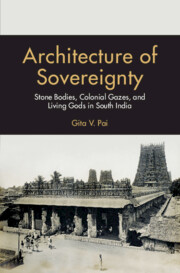Book contents
- Frontmatter
- Dedication
- Contents
- List of Figures
- Acknowledgments
- Notes on Transliteration and Spelling
- Introduction: Sovereignty’s Trace in Architectural Forms
- Part I Stone Bodies
- Part II Colonial Gazes
- Part III Living Gods
- Epilogue: Rejecting the State—Priestly Devotion and Protest in Modern Madurai
- Bibliography
- Index
Introduction: Sovereignty’s Trace in Architectural Forms
Published online by Cambridge University Press: 19 April 2023
- Frontmatter
- Dedication
- Contents
- List of Figures
- Acknowledgments
- Notes on Transliteration and Spelling
- Introduction: Sovereignty’s Trace in Architectural Forms
- Part I Stone Bodies
- Part II Colonial Gazes
- Part III Living Gods
- Epilogue: Rejecting the State—Priestly Devotion and Protest in Modern Madurai
- Bibliography
- Index
Summary
This book begins with a popular legend about an heir apparent, an illness, and a dream. In the seventeenth century, Tirumala Nāyaka, crown prince of the Madurai Nāyaka dynasty in the Tamil region of southeastern India, suffered from chronic catarrh that left him with an upper respiratory infection that neither doctors nor the gods from neighboring temples could cure (Figure I.1). As he journeyed to Madurai for his coronation, Tirumala collapsed from fatigue. That night, goddess Mīnākṣī (Tamil, ‘the fish-eyed one,’ a manifestation of Pārvatī) and god Sundareśvara (‘the beautiful lord,’ the local form of Śiva) appeared in his dream: they promised that if Tirumala moved his kingdom's capital from Tiruchirappalli to Madurai, where the deities dwelled in their temple, they would relieve him of his ailment. After consulting with his Brahmins and court ministers, Tirumala accepted the gods’ request—he vowed that when cured, he would not only make Madurai his permanent home, he would also spend lavishly on the temple by financing its restoration and sponsoring its rituals. According to legend, Tirumala was immediately restored to health, and as Madurai's ruler from 1623 to 1659, he became Mīnākṣī and Sundareśvara's most ardent devotee.
The setting of this book is one of Tirumala's promised projects: the Pudu Maṇḍapam (‘new hall’). Built in the 1630s as a major addition to the Mīnākṣī-Sundareśvara temple complex under Tirumala Nāyaka's patronage, the Pudu Maṇḍapam is one of the best-known monuments from the Nāyaka period (spanning the sixteenth to eighteenth centuries) and one of the largest festival maṇḍapams (‘pillared halls’) in the Indian subcontinent (Figure I.2). While the god's mūla mūrti—its immovable ‘root or original image’—remains in the temple's garbhagṛha (Skt, ‘inner sanctum’), the deity also takes the form of a bronze, movable festival image, or utsava mūrti, which travels from the temple's main shrine and stays in the maṇḍapam during ritual performances. In addition to a stage for religious functions, the Pudu Maṇḍapam boasts massive granite pillars sculpted with gods, mythological figures, and fully modeled portraits of the Nāyaka royal lineage arranged in chronological order—with Tirumala, the patron of the project, at the end. The temple and its pillared hall are the religious and cultural hub of Madurai, and a popular site for tourists and Hindu devotees making pilgrimage.
- Type
- Chapter
- Information
- Architecture of SovereigntyStone Bodies, Colonial Gazes, and Living Gods in South India, pp. 1 - 18Publisher: Cambridge University PressPrint publication year: 2023

